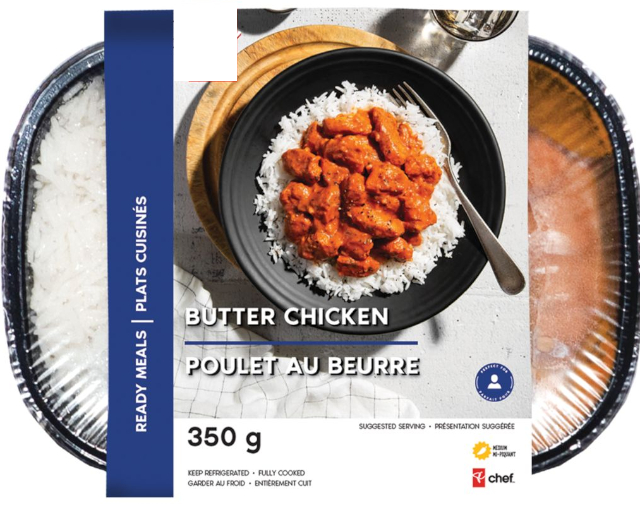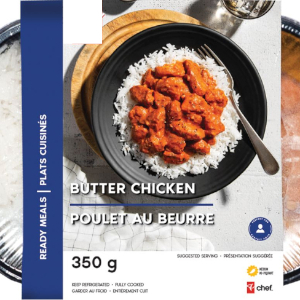I’ve complained bitterly in this space in the past about Supermarket dirty tricks. But this will be the first time I’ve called out a supermarket house brand for shorting customers on the contents of their heat-and-eat frozen dinners. I’ve really got to get this off my chest…
 Typical Frozen Meal: 350 g net wt. is clearly marked, but what does
Typical Frozen Meal: 350 g net wt. is clearly marked, but what does
that mean in terms of how many the package will feed?
I’ve had enough!
Sister Erin brought home some frozen entrées from the supermarket a couple of days ago. They were on sale and sounded good, and the photos on the packages were enticing.
‘Butter Chicken’ the headline on the package proclaimed. The usual ‘Serving Suggestion’ photo showed a fairly large bowl full-up with Rice to the rim and piled with beautiful golden Butter Chicken. Taking into account the size of the fork thrown in as a prop, I estimated the contents of one packet would be sufficient to give Mom and me supper with some leftovers for Breakfast the next morning. Hah!
Checking the ‘numbers’
The small print at the bottom of the front panel of the box said ‘350 g’, and a little voice in my head said, “That seems a bit light, to me…” But the picture looked righteous (see photo, top of page). And besides. Erin had bought the things on sale: no returns. Not yo mention that I didn’t want to seem ungrateful for her for trying to help ease my recently amplified COVID-19 lock down menu-making boredom.
An unpleasant surprise
Then I got my first unpleasant surprise.
The tray was divided into two equal parts, and though the Rice side was filled three-quarters of the way to the top, the Meat and Sauce and Meat side contained a mere 1/2 in. / 1.25 cm of Sauce and a very small grup of precisely 6 Chicken pieces that looked lonely and frightened huddled in the centre of the large-seeming compartment. Some of the pieces were the size indicated in the box photo, but about half were smaller; some only about half the size of the largest other chunks.
So, I microwaved-up BOTH of the trays of Butter Chicken Erin had provided, and dished each up as a single-serving portion. The portions still seemed smallish in regular cereal bowls, but I served the meal as was without comment.
You can’t fool a Mother
Mom immediately said: “You didn’t make this yourself, did you?”
“No, Mother” was all I said.
” I can tell. The portions are a little small. No Salad or anything else to go with?”
“I didn’t think we’d need it.”
“Humpf…”
We ate in silence, which Mother was first to break.
“Flavour was nice,” she pronounced. “Not too spicy but pleasantly zingy. Meat was tender and fairly juicy. But they should still be sued for misrepresentation over the size of the meat portion, based on what they led you to expect based on the box photo.”
“You didn’t even see the box,” I pointed out.
“No, but I’ll bet you dessert they didn’t show the actual contents in the photo. They’ve been pulling that old cheat since before you even started school.”
An interesting, though not particularly remarkable insight. I’d suspected as much.
Some interesting facts
A little research unveiled some interesting facts. Food processors and packagers had, indeed, been sued big time just such scams way back when they first started using them. The vendors quickly came up, not with the idea of being fir and truthful on their packaging, but with the not on that all graphics should be accompanied with disclaimers such as captions warning “Not exactly as shown.” Also, the manufacturers and vendors must have spent hundreds of thousands of dollars on lawyers to come up with stock dodges such as NOT claiming a package, “Feeds [X] number] of adults.” Everything got bald, unexplained numbers for quantities and the legal protections were refined until any later lawsuits slid through the courts without problems, any more.
So, the manufacturers and retailers were thus protected from accountability for their unfair and deceptive actions by reams of small print. These days, nobody bothers complaining about such cheats because they know the sellers’ precautions against the little guys winning are all but bullet-proof. We shrug our shoulders, sigh, and move on, promising ourselves never to buy THAT product or trust THAT brand again.
The underlying issues
The retailers would rather lose a few customers than be caught dead decreasing their package sizes or using truthful photos on their labels while maintaining per-unit prices so they can maintain a small but workable profit. That would make them look suspicious in the eyes of consumers, and indicate weakness to competitors who have been using exactly same old cheats just as long as they have.
What the maker could have done
The first thing I’d have done if offered the job of equalizing the perceived value and the demonstrable value of the product in question was suggest adding some chunks of simmered Potato, just like they traditionally include in so many Indian stews and Lentil dishes.
I’d also have suggested going big with the master (full package) portion sizes while raising the prices enough to come out even, or slightly higher on the plus-side profit-wise. Chef’s Secret: There’s no cheaper ingredient you can use to fill up a plate than Potatoes!
There’s always something you can do to avoid the perception that you’re cheating, even when all the legal ‘t’s are crossed and the ‘i’s are dotted.
What can you do?
Just say ‘No’ to products that disappoint because the maker has cheated on the label. Fight back by doing as my Mom suggested: “With this COVID-19 thing going around, you’ve got all the time in the world. Make big batches of your own ‘scratch’ soups and stews, and freeze them in real-meal-sized portions.”
Thinking back on the pricing picture surrounding the Butter Chicken product we’ve had under the microscope this morning… I’ suggest that we all simply adhere to the old caution that, ‘If something seems too good to be true, it probably is!”
P.S. – Mother won my dessert.
~ Maggie J.

